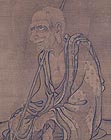Japanese Gallery (Honkan) Room T1
June 28, 2011 (Tue) - July 24, 2011 (Sun)
This exhibition displays Chinese paintings featuring three subjects: arhats, avalokitesvaras, and the monks Han-shan and Shi-de. An arhat is a Buddhist practitioner at a high state of enlightenment who has not yet attained Buddhahood and who remains in this world. Avalokitesvaras are bodhisattvas who, under a variety of guises, also remain in this world to save all living things. Arhats and avalokitesvaras both epitomized the Chinese literati ideal of leaving the world behind to live in seclusion. As a result, they were often the focus of literati paintings. Han-shan and Shi-de were legendary monks who lived at Mount Tiantai, Zhejiang province during the Tang dynasty. A strong freedom of spirit is conveyed through the pair’s facial expressions, as they laugh away the cares of this world.
This exhibition also features Chinese calligraphy from the Ming dynasty. During the mid-Ming dynasty, Suzhou (Jiangsu province) flourished as a merchant town. As the center of economic power shifted to the area, so did many literati. At that time, people wishing to join the state bureaucracy had to pass an imperial examination. Many who failed this test ended up pouring their abundant knowledge into poetry, calligraphy and painting. By devoting themselves to the brush and ink, they managed to earn a living for themselves and in the process gave birth to a new writing style. Calligraphers from this period were known as the “Wu School” after the old name for Suzhou, with Wen Zhengming being a representative figure from this school. At the end of the Ming Dynasty, painters and calligraphers from Songjiang (Shanghai city) took center stage. One member of the “Songjiang School” who particularly excelled at both calligraphy and painting was Dong Qichang, a figure who played a pioneering role in the birth of renmen (continuous line), a style which flourished from the end of the Ming to the beginning of the Qing dynasties.

